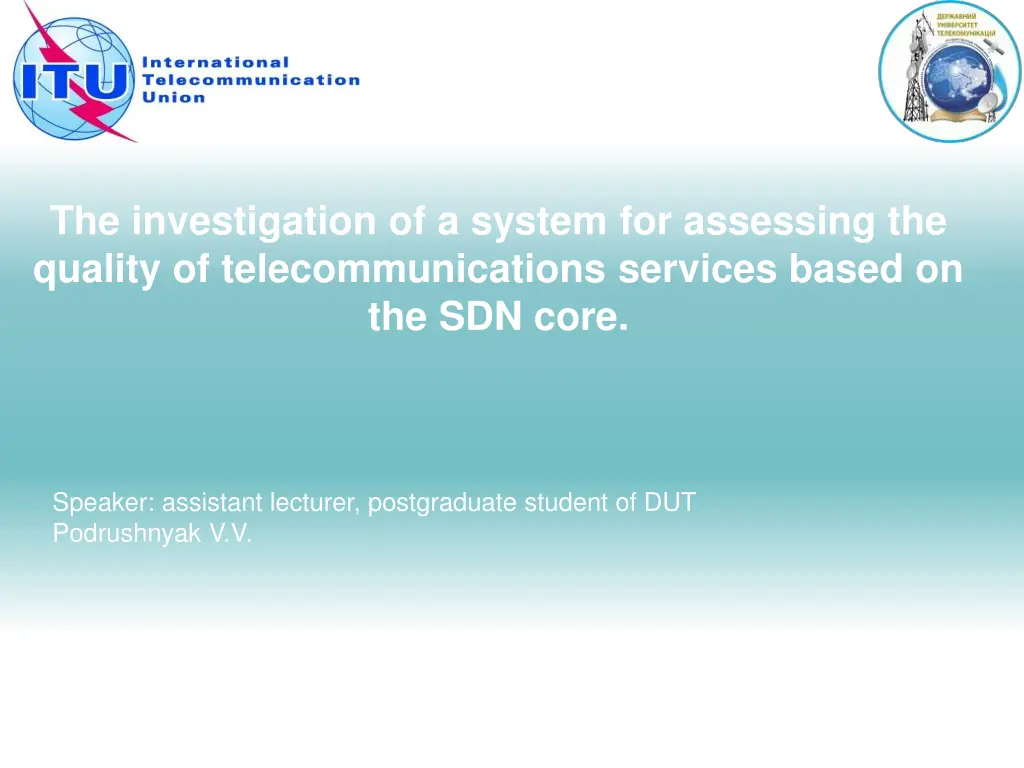
Quality Management System for Telecommunications Services
Explore the investigation of a system for assessing the quality of telecommunications services based on SDN core technology. Delve into the relevance of mobile communication in Ukraine, the complexity of building a quality management system, and the functioning of services quality control. Analyze the regulatory base addressing quality control in telecommunications services in mobile networks and Internet access.
Download Presentation

Please find below an Image/Link to download the presentation.
The content on the website is provided AS IS for your information and personal use only. It may not be sold, licensed, or shared on other websites without obtaining consent from the author. If you encounter any issues during the download, it is possible that the publisher has removed the file from their server.
You are allowed to download the files provided on this website for personal or commercial use, subject to the condition that they are used lawfully. All files are the property of their respective owners.
The content on the website is provided AS IS for your information and personal use only. It may not be sold, licensed, or shared on other websites without obtaining consent from the author.
E N D
Presentation Transcript
The investigation of a system for assessing the quality of telecommunications services based on the SDN core. Speaker: assistant lecturer, postgraduate student of DUT Podrushnyak V.V.
Content 1 Relevance 2 3 Analysis of the regulatory base Formulation of the problem 4 Theoretical research 5 Experimental confirmation 6 Findings Page 2
Relevance Today in Ukraine there are already more than 57 million subscribers of different mobile operators. The penetration level of mobile communication is about 130%. For 14 years, since 2003, the number of mobile subscribers has increased almost 9 times (6.5 million subscribers in 2003 and 57 million in the end of 2017). Just as the number of subscribers, the very concept of mobile phone and mobile communications is rapidly changing. We are no longer just enough phone calls or sms, the mobile phone has become the main means of communication, an integral part of our life. Page 2
Relevance The complexity of building a quality management system is in the following main factors: 1. 2. 3. A lot of subscribers; Many parameters that require quality control; A large number of services for which you need to develop a management system; Placement of equipment for the collection of information; Plan for the collection of information; Select the type of verification: solid or selective. Thus, the creation of a quality management system is an urgent task facing telecom operators in the development of the network in the direction of the multiservice network. 4. 5. 6. Page 2
The functioning of services quality control Based on the general quality concept of ISO 8402, the main terms in the quality of service (QoS) were defined, and are given in Recommendation MCE-T E.800 for the first time. The Recommendation MCE-T E.800 provides the following definition of QoS: "aggregate service determines the degree of user satisfaction with the service". performance indicator that Thus, QoS is not only defined or determined by indicators that can be expressed in technical indicators, but also determined by a subjective indicator that determines the expected and perceived quality for the user. Page 3
Analysis of the regulatory base, which addresses the issues of quality control of telecommunications services in mobile networks and access to the Internet SOU 64.2 00017584 005:2009 Telecommunication networks of mobile (mobile) communication of general use. System of indicators of the quality of mobile services. General Provisions SOU 64.2 00017584 006:2009 Telecommunication networks of mobile communication of general use. Telecommunication services. Quality indicators. Test methods SOU 64.2 00017584 008:2010 Telecommunication networks of data transmission of general use. System of indicators of the quality of services for data transmission and Internet access. General Provisions SOU 61 34620942 011:2012 Telecommunication networks of data transmission of general use. Telecommunication services. The main quality indicators. Test methods Telecommunication networks of data transmission of general use. Telecommunication services. The main quality indicators. Test methods SOU 61 34620942 011:2012 Page 4
Analysis of the regulatory base, which addresses the issues of quality control of telecommunications services in mobile networks and access to the Internet Aspects of processing, transmission of signals of speech information and ensuring their quality (STQ). Identify and measure customer- relevant QoS parameters DSTU ETSI EG 202 057-1:2015 Aspects of processing, transmission of signals of speech information and ensuring their quality (STQ). Identify and measure customer- relevant QoS parameters. Part 2. Voice telephony, group 3 fax services and data and short messages (SMS) using a modem DSTU ETSI EG 202 057-2:2015 Aspects of processing, transmission of signals of speech information and ensuring their quality (STQ). Identify and measure customer- relevant QoS parameters. Part 3. Special Service Quality Parameters for Mobile Public Land Mobile Networks (PLMN) DSTU ETSI EG 202 057-3:2015 Aspects of processing, transmission of signals of speech information and ensuring their quality (STQ). Identify and measure customer- relevant QoS parameters DSTU ETSI EG 202 057-4:2015 Framework for monitoring the quality of service of IP network services ITU-T Y.1545.1 Fundamental voice transmission objectives for VoIP terminals and gateways ITU-T P.1010 Methods, metrics and procedures for statistical evaluation, qualification and comparison of objective quality prediction models ITU-T P.1401 Page 5
Simplified architecture SDN Page 8
Service Quality Assessment System Service control system Service control system Service control system Page 7
The mechanism of jitter formation ? = ? + ??? ????+ ?? , when = ? ??, Page 11
The mechanism of jitter formation (continued) Determination of the average delay value ???? ? = ??? ?(?? ?=???? Minimal delay will occur when ? ???= ? , and the maximum at ? ???= ? + ?? . In this case, the probability of occurrence of a minimum delay will be provided that ? = 0: (? ???) = (? = 0), The maximum delay, provided that ? = ????: (? ???) = (? = ????). Thus, it is necessary to determine the probability that the sum of the packet length ??will be greater than ? , and also the probability of occurrence of each value of this difference. Page 12
Determination of the probabilistic characteristics of jitter Determination of the average delay value 235-243 0,065 n n 131-139 (n) (n) 0,002 65 2 139-147 0,002 33 243-251 0,033 2 147-155 0,018 20 251-259 0,02 18 155-163 0,028 18 259-267 0,018 28 163-171 0,057 6 267-275 0,006 57 171-179 0,084 9 275-283 0,009 84 179-187 0,109 2 283-291 0,002 109 187-195 0,118 4 291-299 0,004 118 203-211 0,116 1 299-307 0,001 116 211-219 0,112 1 307-315 0,001 112 219-227 0,114 1 315-323 0,001 114 227-235 0,079 1 323-331 0,001 79 Page 13
Determination of the probabilistic characteristics of jitter (continued) Calculation of the characteristic function of a random variable g(t) = k=1 ???????, where ?? packet length, ?? Probability of arrival of a package with length ??. ? Density of the allocation of the sum of the lengths of random packets ? ???g?(?)??. 1 ? ? = 2? In our case, we use the discrete Fourier transform, which has the form: ? 1 ??cos2? ??? ??sin2? ??= ??? , ? = 0,1,2 ? 1 , ?=0 where 1 ? ?=0 ? 1?????2? ??? ; ??= ? 1?????2? ??= 1 ??? ,(? = 0,1,2, ,? 1). ? ?=0 Page 14
Distributions of the probability density from the number of packets in the queue Page 15
Experimental confirmation of the theoretical results Physical Architecture Page 16
Experimental confirmation of the theoretical results Logicalarchitecture Page 17
The scheme of the traffic quality management system via the RTP protocol Page 18
Conclusion The use of SDN technology in 4G / 5G networks will allow implementation of algorithms for measuring and evaluating the quality parameters services, which are used by national regulators to monitor the quality of services provided. And also allows to create a quality management system that is implemented within the operator / provider, which ensures a guaranteed quality of service provision. efficient and flexible of transmitted Page 20







